MDB3023: Stress and its Impact on Academic Performance & Well-being
VerifiedAdded on 2024/07/04
|61
|16539
|474
Report
AI Summary
This report investigates the intricate relationship between stress, academic performance, and overall well-being among university students. It begins by establishing the background of stress in academic life, highlighting how family dynamics, individual perceptions, and environmental factors contribute to student stress levels. The problem statement delves into specific stressors, such as family expectations, perceptions of academic challenges, environmental pressures, and peer relationships. The research questions and objectives are clearly defined, emphasizing the significance and scope of the study. A literature review explores various theories of stress, sources of stress (family, perception, environment, and peer relationships), and their impact on academic performance and well-being, including social, physical, and emotional dimensions. The report also introduces the Transactional Model of Stress Theory and presents a theoretical framework. The methodology section details the research paradigm, design, instruments, reliability, pilot testing, population, sampling, data analysis, and collection methods, including a model specification for multiple regression analysis. The results and findings chapter presents descriptive and demographic analyses, reliability assessments, and simple regression analysis. Finally, the report concludes with a discussion of the findings and recommendations for improving student well-being and academic performance.
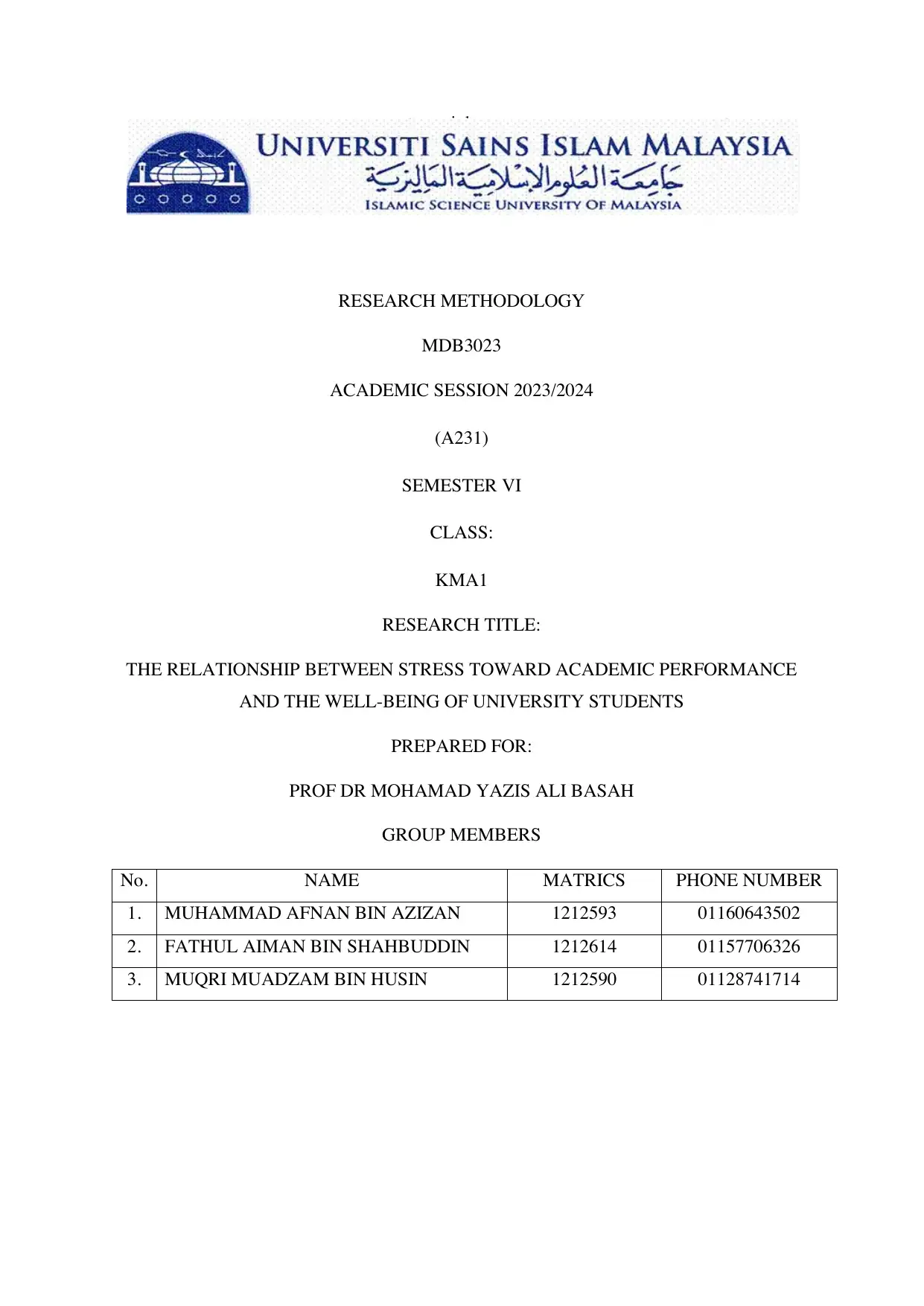
sight
RESEARCH METHODOLOGY
MDB3023
ACADEMIC SESSION 2023/2024
(A231)
SEMESTER VI
CLASS:
KMA1
RESEARCH TITLE:
THE RELATIONSHIP BETWEEN STRESS TOWARD ACADEMIC PERFORMANCE
AND THE WELL-BEING OF UNIVERSITY STUDENTS
PREPARED FOR:
PROF DR MOHAMAD YAZIS ALI BASAH
GROUP MEMBERS
No. NAME MATRICS PHONE NUMBER
1. MUHAMMAD AFNAN BIN AZIZAN 1212593 01160643502
2. FATHUL AIMAN BIN SHAHBUDDIN 1212614 01157706326
3. MUQRI MUADZAM BIN HUSIN 1212590 01128741714
RESEARCH METHODOLOGY
MDB3023
ACADEMIC SESSION 2023/2024
(A231)
SEMESTER VI
CLASS:
KMA1
RESEARCH TITLE:
THE RELATIONSHIP BETWEEN STRESS TOWARD ACADEMIC PERFORMANCE
AND THE WELL-BEING OF UNIVERSITY STUDENTS
PREPARED FOR:
PROF DR MOHAMAD YAZIS ALI BASAH
GROUP MEMBERS
No. NAME MATRICS PHONE NUMBER
1. MUHAMMAD AFNAN BIN AZIZAN 1212593 01160643502
2. FATHUL AIMAN BIN SHAHBUDDIN 1212614 01157706326
3. MUQRI MUADZAM BIN HUSIN 1212590 01128741714
Paraphrase This Document
Need a fresh take? Get an instant paraphrase of this document with our AI Paraphraser
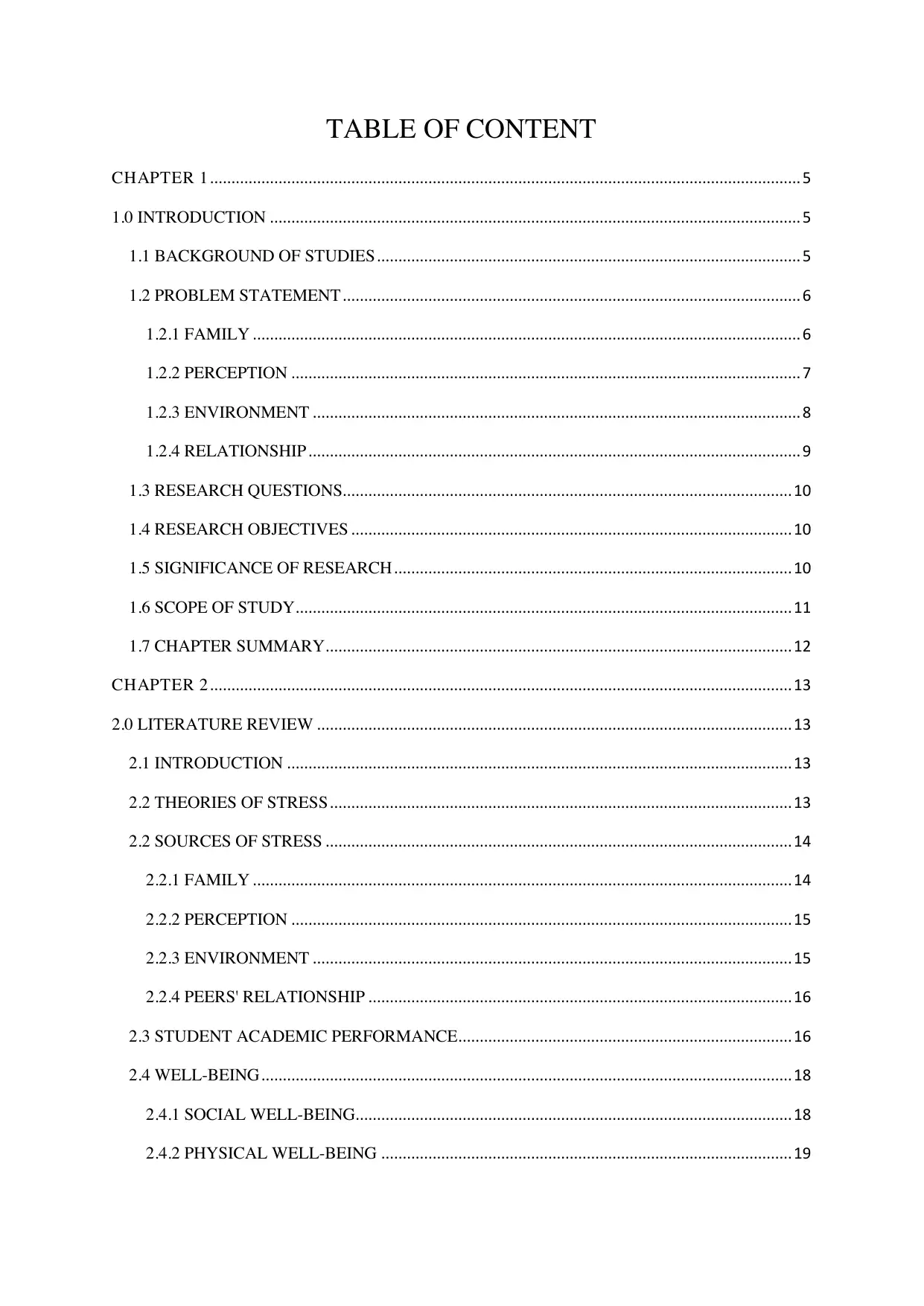
TABLE OF CONTENT
CHAPTER 1 .......................................................................................................................................... 5
1.0 INTRODUCTION ............................................................................................................................ 5
1.1 BACKGROUND OF STUDIES ................................................................................................... 5
1.2 PROBLEM STATEMENT ........................................................................................................... 6
1.2.1 FAMILY ................................................................................................................................ 6
1.2.2 PERCEPTION ....................................................................................................................... 7
1.2.3 ENVIRONMENT .................................................................................................................. 8
1.2.4 RELATIONSHIP ................................................................................................................... 9
1.3 RESEARCH QUESTIONS......................................................................................................... 10
1.4 RESEARCH OBJECTIVES ....................................................................................................... 10
1.5 SIGNIFICANCE OF RESEARCH ............................................................................................. 10
1.6 SCOPE OF STUDY .................................................................................................................... 11
1.7 CHAPTER SUMMARY ............................................................................................................. 12
CHAPTER 2 ........................................................................................................................................ 13
2.0 LITERATURE REVIEW ............................................................................................................... 13
2.1 INTRODUCTION ...................................................................................................................... 13
2.2 THEORIES OF STRESS ............................................................................................................ 13
2.2 SOURCES OF STRESS ............................................................................................................. 14
2.2.1 FAMILY .............................................................................................................................. 14
2.2.2 PERCEPTION ..................................................................................................................... 15
2.2.3 ENVIRONMENT ................................................................................................................ 15
2.2.4 PEERS' RELATIONSHIP ................................................................................................... 16
2.3 STUDENT ACADEMIC PERFORMANCE.............................................................................. 16
2.4 WELL-BEING ............................................................................................................................ 18
2.4.1 SOCIAL WELL-BEING...................................................................................................... 18
2.4.2 PHYSICAL WELL-BEING ................................................................................................ 19
CHAPTER 1 .......................................................................................................................................... 5
1.0 INTRODUCTION ............................................................................................................................ 5
1.1 BACKGROUND OF STUDIES ................................................................................................... 5
1.2 PROBLEM STATEMENT ........................................................................................................... 6
1.2.1 FAMILY ................................................................................................................................ 6
1.2.2 PERCEPTION ....................................................................................................................... 7
1.2.3 ENVIRONMENT .................................................................................................................. 8
1.2.4 RELATIONSHIP ................................................................................................................... 9
1.3 RESEARCH QUESTIONS......................................................................................................... 10
1.4 RESEARCH OBJECTIVES ....................................................................................................... 10
1.5 SIGNIFICANCE OF RESEARCH ............................................................................................. 10
1.6 SCOPE OF STUDY .................................................................................................................... 11
1.7 CHAPTER SUMMARY ............................................................................................................. 12
CHAPTER 2 ........................................................................................................................................ 13
2.0 LITERATURE REVIEW ............................................................................................................... 13
2.1 INTRODUCTION ...................................................................................................................... 13
2.2 THEORIES OF STRESS ............................................................................................................ 13
2.2 SOURCES OF STRESS ............................................................................................................. 14
2.2.1 FAMILY .............................................................................................................................. 14
2.2.2 PERCEPTION ..................................................................................................................... 15
2.2.3 ENVIRONMENT ................................................................................................................ 15
2.2.4 PEERS' RELATIONSHIP ................................................................................................... 16
2.3 STUDENT ACADEMIC PERFORMANCE.............................................................................. 16
2.4 WELL-BEING ............................................................................................................................ 18
2.4.1 SOCIAL WELL-BEING...................................................................................................... 18
2.4.2 PHYSICAL WELL-BEING ................................................................................................ 19
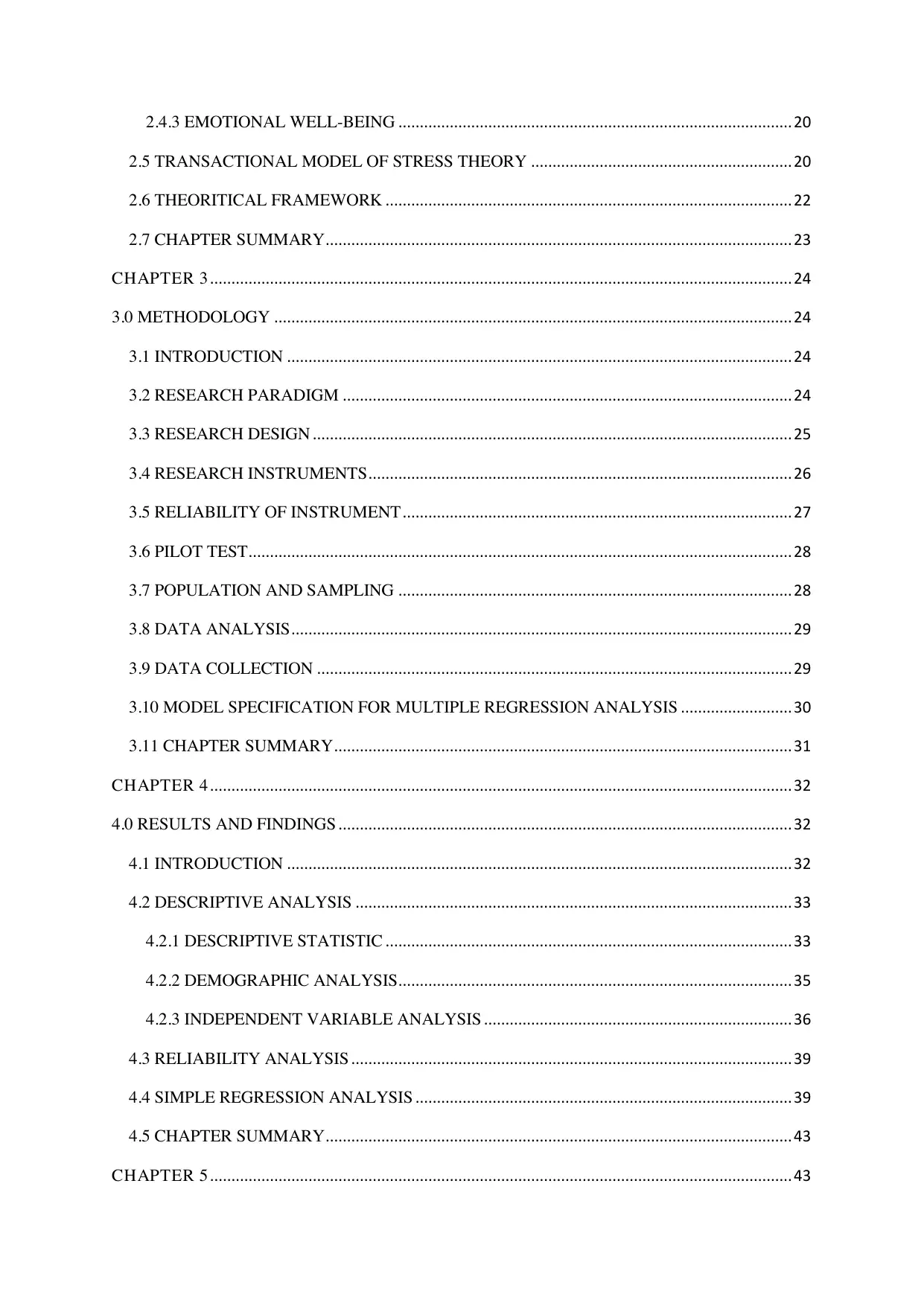
2.4.3 EMOTIONAL WELL-BEING ............................................................................................ 20
2.5 TRANSACTIONAL MODEL OF STRESS THEORY ............................................................. 20
2.6 THEORITICAL FRAMEWORK ............................................................................................... 22
2.7 CHAPTER SUMMARY ............................................................................................................. 23
CHAPTER 3 ........................................................................................................................................ 24
3.0 METHODOLOGY ......................................................................................................................... 24
3.1 INTRODUCTION ...................................................................................................................... 24
3.2 RESEARCH PARADIGM ......................................................................................................... 24
3.3 RESEARCH DESIGN ................................................................................................................ 25
3.4 RESEARCH INSTRUMENTS ................................................................................................... 26
3.5 RELIABILITY OF INSTRUMENT ........................................................................................... 27
3.6 PILOT TEST ............................................................................................................................... 28
3.7 POPULATION AND SAMPLING ............................................................................................ 28
3.8 DATA ANALYSIS ..................................................................................................................... 29
3.9 DATA COLLECTION ............................................................................................................... 29
3.10 MODEL SPECIFICATION FOR MULTIPLE REGRESSION ANALYSIS .......................... 30
3.11 CHAPTER SUMMARY ........................................................................................................... 31
CHAPTER 4 ........................................................................................................................................ 32
4.0 RESULTS AND FINDINGS .......................................................................................................... 32
4.1 INTRODUCTION ...................................................................................................................... 32
4.2 DESCRIPTIVE ANALYSIS ...................................................................................................... 33
4.2.1 DESCRIPTIVE STATISTIC ............................................................................................... 33
4.2.2 DEMOGRAPHIC ANALYSIS............................................................................................ 35
4.2.3 INDEPENDENT VARIABLE ANALYSIS ........................................................................ 36
4.3 RELIABILITY ANALYSIS ....................................................................................................... 39
4.4 SIMPLE REGRESSION ANALYSIS ........................................................................................ 39
4.5 CHAPTER SUMMARY ............................................................................................................. 43
CHAPTER 5 ........................................................................................................................................ 43
2.5 TRANSACTIONAL MODEL OF STRESS THEORY ............................................................. 20
2.6 THEORITICAL FRAMEWORK ............................................................................................... 22
2.7 CHAPTER SUMMARY ............................................................................................................. 23
CHAPTER 3 ........................................................................................................................................ 24
3.0 METHODOLOGY ......................................................................................................................... 24
3.1 INTRODUCTION ...................................................................................................................... 24
3.2 RESEARCH PARADIGM ......................................................................................................... 24
3.3 RESEARCH DESIGN ................................................................................................................ 25
3.4 RESEARCH INSTRUMENTS ................................................................................................... 26
3.5 RELIABILITY OF INSTRUMENT ........................................................................................... 27
3.6 PILOT TEST ............................................................................................................................... 28
3.7 POPULATION AND SAMPLING ............................................................................................ 28
3.8 DATA ANALYSIS ..................................................................................................................... 29
3.9 DATA COLLECTION ............................................................................................................... 29
3.10 MODEL SPECIFICATION FOR MULTIPLE REGRESSION ANALYSIS .......................... 30
3.11 CHAPTER SUMMARY ........................................................................................................... 31
CHAPTER 4 ........................................................................................................................................ 32
4.0 RESULTS AND FINDINGS .......................................................................................................... 32
4.1 INTRODUCTION ...................................................................................................................... 32
4.2 DESCRIPTIVE ANALYSIS ...................................................................................................... 33
4.2.1 DESCRIPTIVE STATISTIC ............................................................................................... 33
4.2.2 DEMOGRAPHIC ANALYSIS............................................................................................ 35
4.2.3 INDEPENDENT VARIABLE ANALYSIS ........................................................................ 36
4.3 RELIABILITY ANALYSIS ....................................................................................................... 39
4.4 SIMPLE REGRESSION ANALYSIS ........................................................................................ 39
4.5 CHAPTER SUMMARY ............................................................................................................. 43
CHAPTER 5 ........................................................................................................................................ 43
⊘ This is a preview!⊘
Do you want full access?
Subscribe today to unlock all pages.

Trusted by 1+ million students worldwide
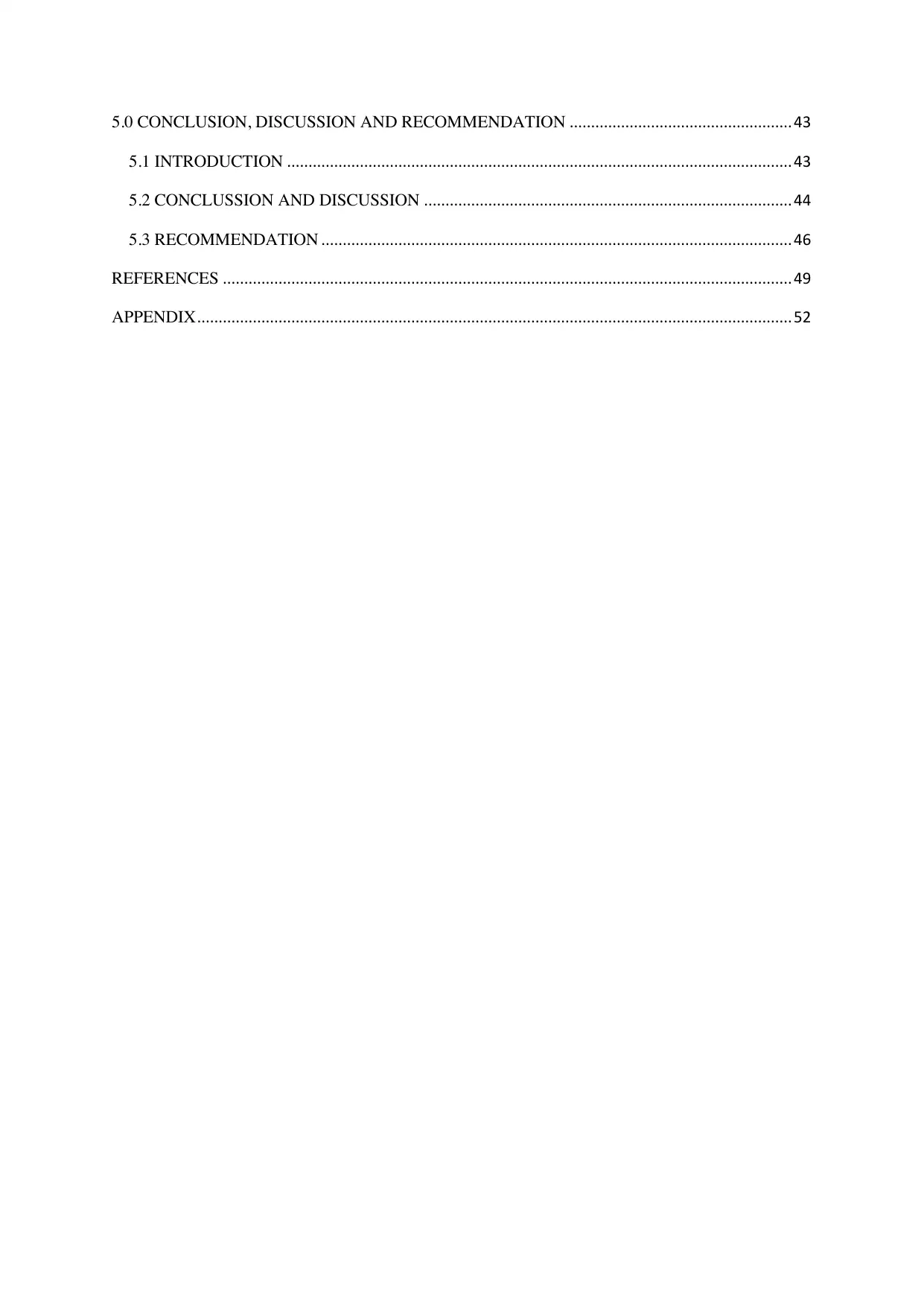
5.0 CONCLUSION, DISCUSSION AND RECOMMENDATION .................................................... 43
5.1 INTRODUCTION ...................................................................................................................... 43
5.2 CONCLUSSION AND DISCUSSION ...................................................................................... 44
5.3 RECOMMENDATION .............................................................................................................. 46
REFERENCES ..................................................................................................................................... 49
APPENDIX ........................................................................................................................................... 52
5.1 INTRODUCTION ...................................................................................................................... 43
5.2 CONCLUSSION AND DISCUSSION ...................................................................................... 44
5.3 RECOMMENDATION .............................................................................................................. 46
REFERENCES ..................................................................................................................................... 49
APPENDIX ........................................................................................................................................... 52
Paraphrase This Document
Need a fresh take? Get an instant paraphrase of this document with our AI Paraphraser
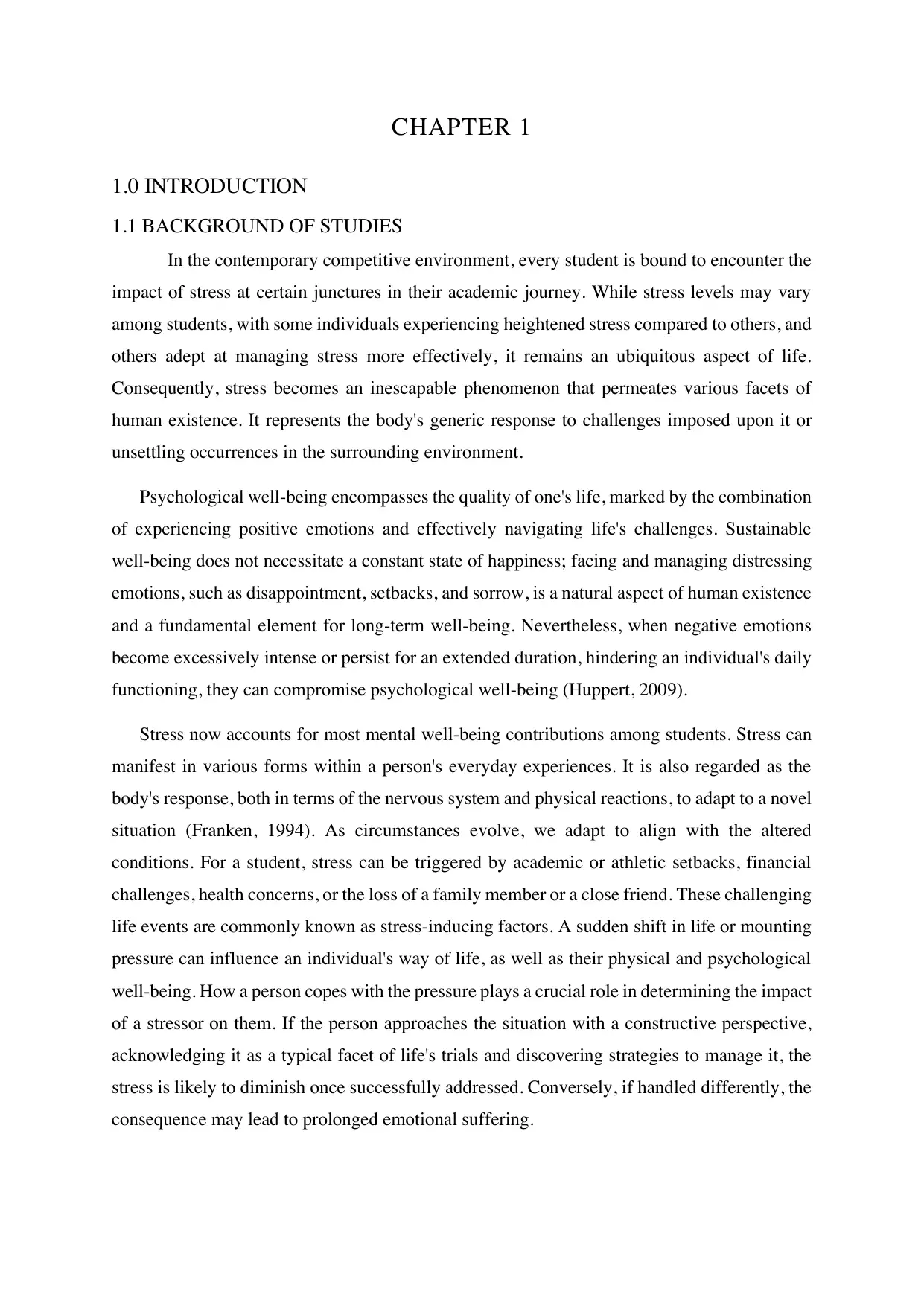
CHAPTER 1
1.0 INTRODUCTION
1.1 BACKGROUND OF STUDIES
In the contemporary competitive environment, every student is bound to encounter the
impact of stress at certain junctures in their academic journey. While stress levels may vary
among students, with some individuals experiencing heightened stress compared to others, and
others adept at managing stress more effectively, it remains an ubiquitous aspect of life.
Consequently, stress becomes an inescapable phenomenon that permeates various facets of
human existence. It represents the body's generic response to challenges imposed upon it or
unsettling occurrences in the surrounding environment.
Psychological well-being encompasses the quality of one's life, marked by the combination
of experiencing positive emotions and effectively navigating life's challenges. Sustainable
well-being does not necessitate a constant state of happiness; facing and managing distressing
emotions, such as disappointment, setbacks, and sorrow, is a natural aspect of human existence
and a fundamental element for long-term well-being. Nevertheless, when negative emotions
become excessively intense or persist for an extended duration, hindering an individual's daily
functioning, they can compromise psychological well-being (Huppert, 2009).
Stress now accounts for most mental well-being contributions among students. Stress can
manifest in various forms within a person's everyday experiences. It is also regarded as the
body's response, both in terms of the nervous system and physical reactions, to adapt to a novel
situation (Franken, 1994). As circumstances evolve, we adapt to align with the altered
conditions. For a student, stress can be triggered by academic or athletic setbacks, financial
challenges, health concerns, or the loss of a family member or a close friend. These challenging
life events are commonly known as stress-inducing factors. A sudden shift in life or mounting
pressure can influence an individual's way of life, as well as their physical and psychological
well-being. How a person copes with the pressure plays a crucial role in determining the impact
of a stressor on them. If the person approaches the situation with a constructive perspective,
acknowledging it as a typical facet of life's trials and discovering strategies to manage it, the
stress is likely to diminish once successfully addressed. Conversely, if handled differently, the
consequence may lead to prolonged emotional suffering.
1.0 INTRODUCTION
1.1 BACKGROUND OF STUDIES
In the contemporary competitive environment, every student is bound to encounter the
impact of stress at certain junctures in their academic journey. While stress levels may vary
among students, with some individuals experiencing heightened stress compared to others, and
others adept at managing stress more effectively, it remains an ubiquitous aspect of life.
Consequently, stress becomes an inescapable phenomenon that permeates various facets of
human existence. It represents the body's generic response to challenges imposed upon it or
unsettling occurrences in the surrounding environment.
Psychological well-being encompasses the quality of one's life, marked by the combination
of experiencing positive emotions and effectively navigating life's challenges. Sustainable
well-being does not necessitate a constant state of happiness; facing and managing distressing
emotions, such as disappointment, setbacks, and sorrow, is a natural aspect of human existence
and a fundamental element for long-term well-being. Nevertheless, when negative emotions
become excessively intense or persist for an extended duration, hindering an individual's daily
functioning, they can compromise psychological well-being (Huppert, 2009).
Stress now accounts for most mental well-being contributions among students. Stress can
manifest in various forms within a person's everyday experiences. It is also regarded as the
body's response, both in terms of the nervous system and physical reactions, to adapt to a novel
situation (Franken, 1994). As circumstances evolve, we adapt to align with the altered
conditions. For a student, stress can be triggered by academic or athletic setbacks, financial
challenges, health concerns, or the loss of a family member or a close friend. These challenging
life events are commonly known as stress-inducing factors. A sudden shift in life or mounting
pressure can influence an individual's way of life, as well as their physical and psychological
well-being. How a person copes with the pressure plays a crucial role in determining the impact
of a stressor on them. If the person approaches the situation with a constructive perspective,
acknowledging it as a typical facet of life's trials and discovering strategies to manage it, the
stress is likely to diminish once successfully addressed. Conversely, if handled differently, the
consequence may lead to prolonged emotional suffering.
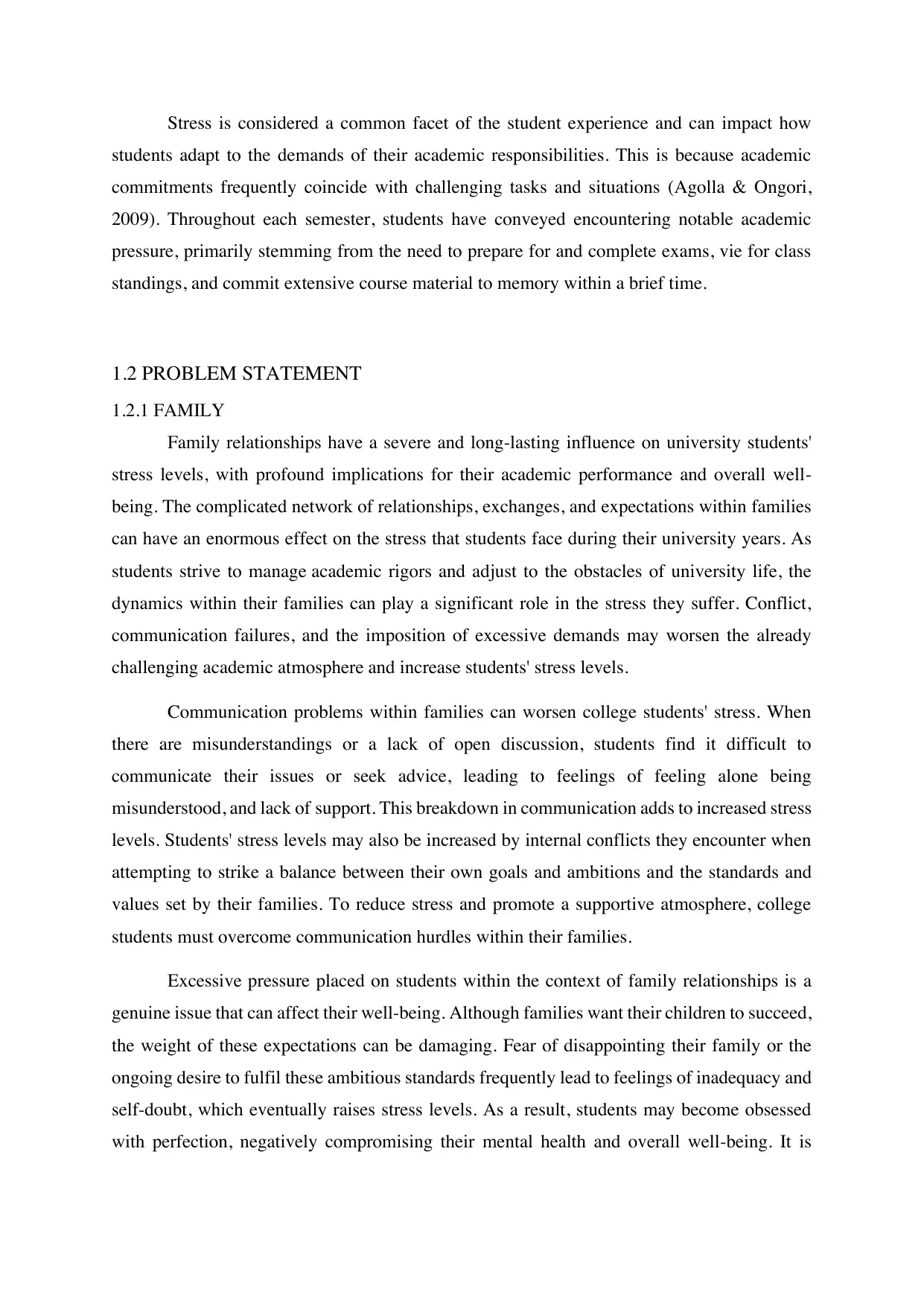
Stress is considered a common facet of the student experience and can impact how
students adapt to the demands of their academic responsibilities. This is because academic
commitments frequently coincide with challenging tasks and situations (Agolla & Ongori,
2009). Throughout each semester, students have conveyed encountering notable academic
pressure, primarily stemming from the need to prepare for and complete exams, vie for class
standings, and commit extensive course material to memory within a brief time.
1.2 PROBLEM STATEMENT
1.2.1 FAMILY
Family relationships have a severe and long-lasting influence on university students'
stress levels, with profound implications for their academic performance and overall well-
being. The complicated network of relationships, exchanges, and expectations within families
can have an enormous effect on the stress that students face during their university years. As
students strive to manage academic rigors and adjust to the obstacles of university life, the
dynamics within their families can play a significant role in the stress they suffer. Conflict,
communication failures, and the imposition of excessive demands may worsen the already
challenging academic atmosphere and increase students' stress levels.
Communication problems within families can worsen college students' stress. When
there are misunderstandings or a lack of open discussion, students find it difficult to
communicate their issues or seek advice, leading to feelings of feeling alone being
misunderstood, and lack of support. This breakdown in communication adds to increased stress
levels. Students' stress levels may also be increased by internal conflicts they encounter when
attempting to strike a balance between their own goals and ambitions and the standards and
values set by their families. To reduce stress and promote a supportive atmosphere, college
students must overcome communication hurdles within their families.
Excessive pressure placed on students within the context of family relationships is a
genuine issue that can affect their well-being. Although families want their children to succeed,
the weight of these expectations can be damaging. Fear of disappointing their family or the
ongoing desire to fulfil these ambitious standards frequently lead to feelings of inadequacy and
self-doubt, which eventually raises stress levels. As a result, students may become obsessed
with perfection, negatively compromising their mental health and overall well-being. It is
students adapt to the demands of their academic responsibilities. This is because academic
commitments frequently coincide with challenging tasks and situations (Agolla & Ongori,
2009). Throughout each semester, students have conveyed encountering notable academic
pressure, primarily stemming from the need to prepare for and complete exams, vie for class
standings, and commit extensive course material to memory within a brief time.
1.2 PROBLEM STATEMENT
1.2.1 FAMILY
Family relationships have a severe and long-lasting influence on university students'
stress levels, with profound implications for their academic performance and overall well-
being. The complicated network of relationships, exchanges, and expectations within families
can have an enormous effect on the stress that students face during their university years. As
students strive to manage academic rigors and adjust to the obstacles of university life, the
dynamics within their families can play a significant role in the stress they suffer. Conflict,
communication failures, and the imposition of excessive demands may worsen the already
challenging academic atmosphere and increase students' stress levels.
Communication problems within families can worsen college students' stress. When
there are misunderstandings or a lack of open discussion, students find it difficult to
communicate their issues or seek advice, leading to feelings of feeling alone being
misunderstood, and lack of support. This breakdown in communication adds to increased stress
levels. Students' stress levels may also be increased by internal conflicts they encounter when
attempting to strike a balance between their own goals and ambitions and the standards and
values set by their families. To reduce stress and promote a supportive atmosphere, college
students must overcome communication hurdles within their families.
Excessive pressure placed on students within the context of family relationships is a
genuine issue that can affect their well-being. Although families want their children to succeed,
the weight of these expectations can be damaging. Fear of disappointing their family or the
ongoing desire to fulfil these ambitious standards frequently lead to feelings of inadequacy and
self-doubt, which eventually raises stress levels. As a result, students may become obsessed
with perfection, negatively compromising their mental health and overall well-being. It is
⊘ This is a preview!⊘
Do you want full access?
Subscribe today to unlock all pages.

Trusted by 1+ million students worldwide
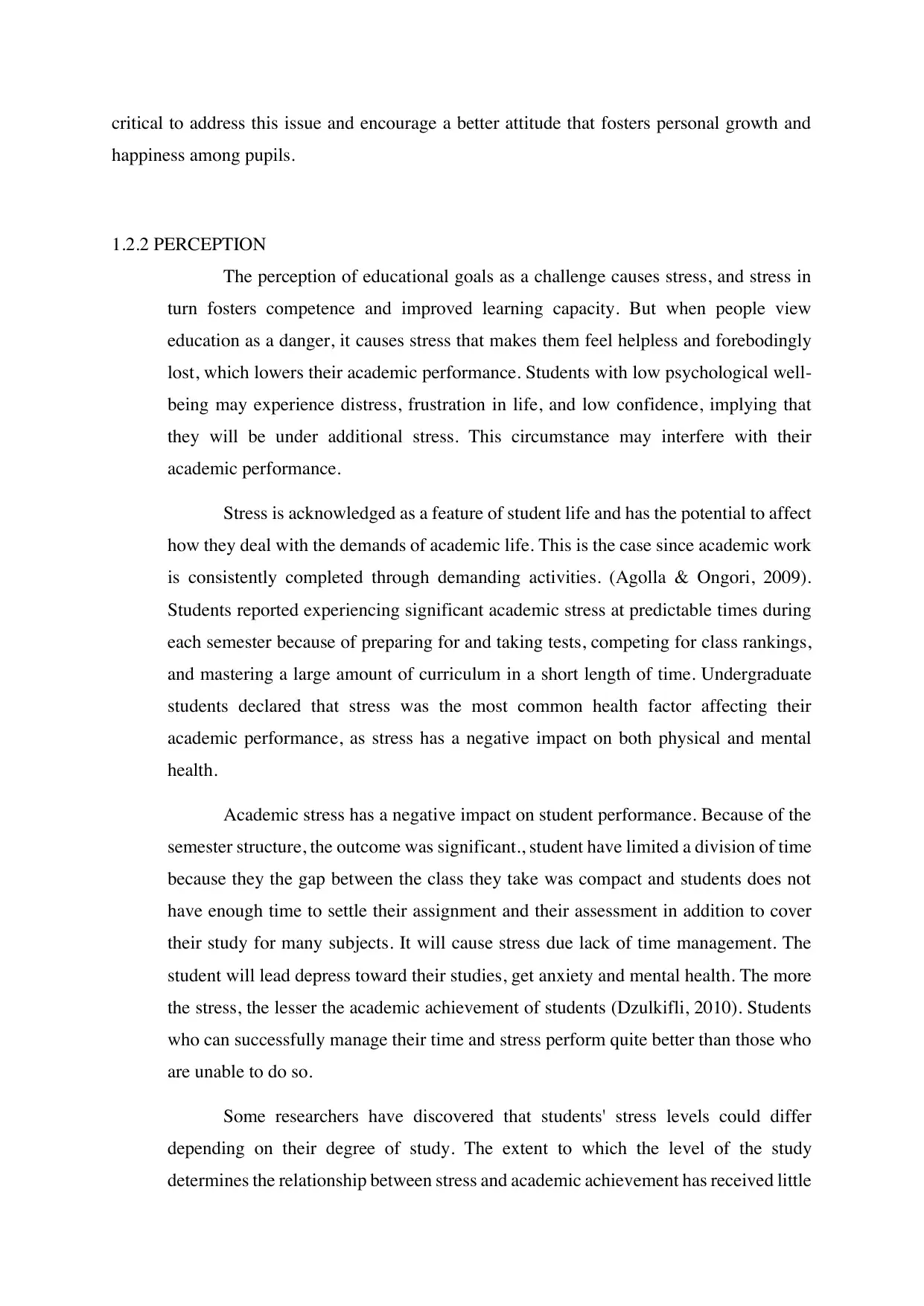
critical to address this issue and encourage a better attitude that fosters personal growth and
happiness among pupils.
1.2.2 PERCEPTION
The perception of educational goals as a challenge causes stress, and stress in
turn fosters competence and improved learning capacity. But when people view
education as a danger, it causes stress that makes them feel helpless and forebodingly
lost, which lowers their academic performance. Students with low psychological well-
being may experience distress, frustration in life, and low confidence, implying that
they will be under additional stress. This circumstance may interfere with their
academic performance.
Stress is acknowledged as a feature of student life and has the potential to affect
how they deal with the demands of academic life. This is the case since academic work
is consistently completed through demanding activities. (Agolla & Ongori, 2009).
Students reported experiencing significant academic stress at predictable times during
each semester because of preparing for and taking tests, competing for class rankings,
and mastering a large amount of curriculum in a short length of time. Undergraduate
students declared that stress was the most common health factor affecting their
academic performance, as stress has a negative impact on both physical and mental
health.
Academic stress has a negative impact on student performance. Because of the
semester structure, the outcome was significant., student have limited a division of time
because they the gap between the class they take was compact and students does not
have enough time to settle their assignment and their assessment in addition to cover
their study for many subjects. It will cause stress due lack of time management. The
student will lead depress toward their studies, get anxiety and mental health. The more
the stress, the lesser the academic achievement of students (Dzulkifli, 2010). Students
who can successfully manage their time and stress perform quite better than those who
are unable to do so.
Some researchers have discovered that students' stress levels could differ
depending on their degree of study. The extent to which the level of the study
determines the relationship between stress and academic achievement has received little
happiness among pupils.
1.2.2 PERCEPTION
The perception of educational goals as a challenge causes stress, and stress in
turn fosters competence and improved learning capacity. But when people view
education as a danger, it causes stress that makes them feel helpless and forebodingly
lost, which lowers their academic performance. Students with low psychological well-
being may experience distress, frustration in life, and low confidence, implying that
they will be under additional stress. This circumstance may interfere with their
academic performance.
Stress is acknowledged as a feature of student life and has the potential to affect
how they deal with the demands of academic life. This is the case since academic work
is consistently completed through demanding activities. (Agolla & Ongori, 2009).
Students reported experiencing significant academic stress at predictable times during
each semester because of preparing for and taking tests, competing for class rankings,
and mastering a large amount of curriculum in a short length of time. Undergraduate
students declared that stress was the most common health factor affecting their
academic performance, as stress has a negative impact on both physical and mental
health.
Academic stress has a negative impact on student performance. Because of the
semester structure, the outcome was significant., student have limited a division of time
because they the gap between the class they take was compact and students does not
have enough time to settle their assignment and their assessment in addition to cover
their study for many subjects. It will cause stress due lack of time management. The
student will lead depress toward their studies, get anxiety and mental health. The more
the stress, the lesser the academic achievement of students (Dzulkifli, 2010). Students
who can successfully manage their time and stress perform quite better than those who
are unable to do so.
Some researchers have discovered that students' stress levels could differ
depending on their degree of study. The extent to which the level of the study
determines the relationship between stress and academic achievement has received little
Paraphrase This Document
Need a fresh take? Get an instant paraphrase of this document with our AI Paraphraser
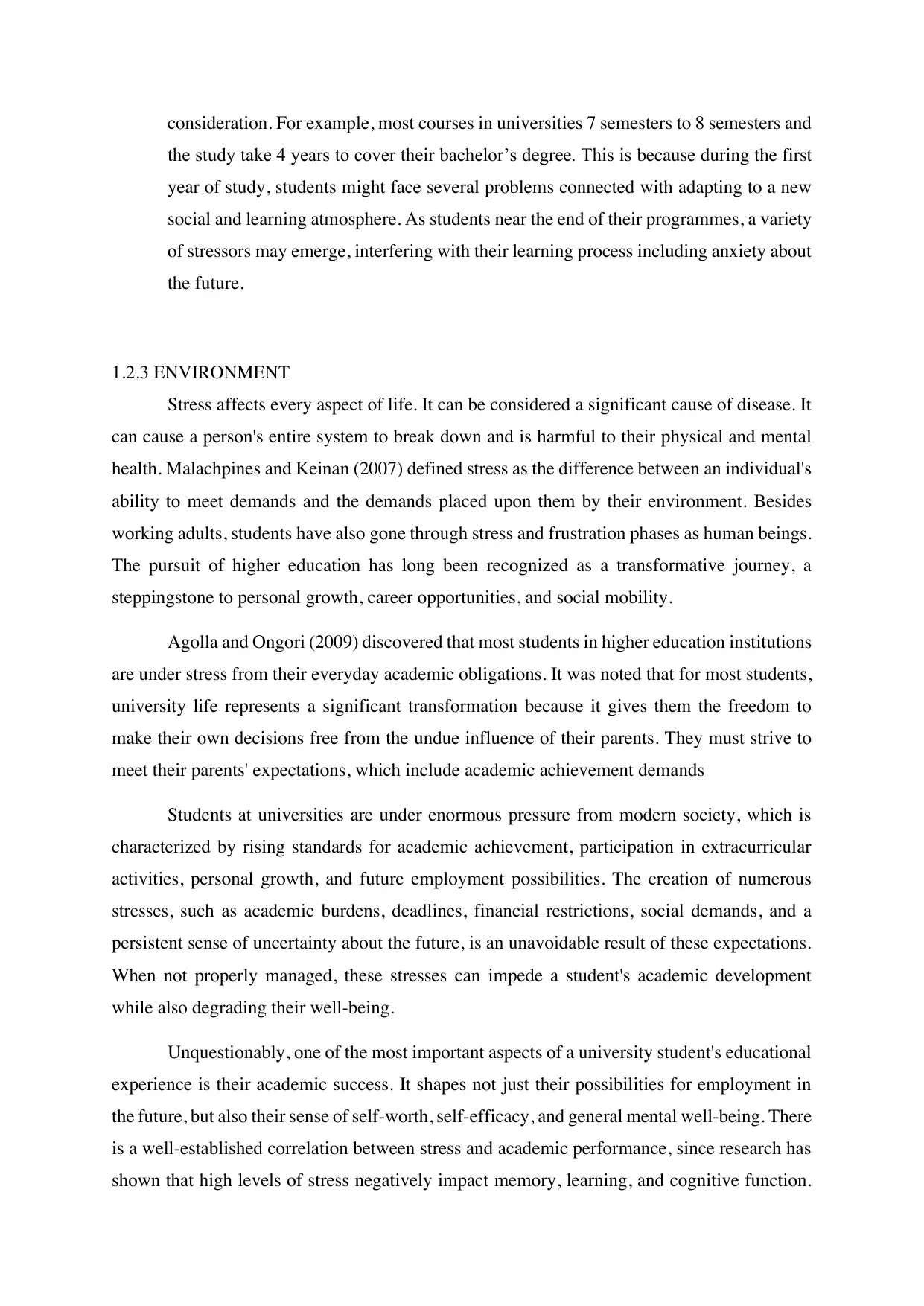
consideration. For example, most courses in universities 7 semesters to 8 semesters and
the study take 4 years to cover their bachelor’s degree. This is because during the first
year of study, students might face several problems connected with adapting to a new
social and learning atmosphere. As students near the end of their programmes, a variety
of stressors may emerge, interfering with their learning process including anxiety about
the future.
1.2.3 ENVIRONMENT
Stress affects every aspect of life. It can be considered a significant cause of disease. It
can cause a person's entire system to break down and is harmful to their physical and mental
health. Malachpines and Keinan (2007) defined stress as the difference between an individual's
ability to meet demands and the demands placed upon them by their environment. Besides
working adults, students have also gone through stress and frustration phases as human beings.
The pursuit of higher education has long been recognized as a transformative journey, a
steppingstone to personal growth, career opportunities, and social mobility.
Agolla and Ongori (2009) discovered that most students in higher education institutions
are under stress from their everyday academic obligations. It was noted that for most students,
university life represents a significant transformation because it gives them the freedom to
make their own decisions free from the undue influence of their parents. They must strive to
meet their parents' expectations, which include academic achievement demands
Students at universities are under enormous pressure from modern society, which is
characterized by rising standards for academic achievement, participation in extracurricular
activities, personal growth, and future employment possibilities. The creation of numerous
stresses, such as academic burdens, deadlines, financial restrictions, social demands, and a
persistent sense of uncertainty about the future, is an unavoidable result of these expectations.
When not properly managed, these stresses can impede a student's academic development
while also degrading their well-being.
Unquestionably, one of the most important aspects of a university student's educational
experience is their academic success. It shapes not just their possibilities for employment in
the future, but also their sense of self-worth, self-efficacy, and general mental well-being. There
is a well-established correlation between stress and academic performance, since research has
shown that high levels of stress negatively impact memory, learning, and cognitive function.
the study take 4 years to cover their bachelor’s degree. This is because during the first
year of study, students might face several problems connected with adapting to a new
social and learning atmosphere. As students near the end of their programmes, a variety
of stressors may emerge, interfering with their learning process including anxiety about
the future.
1.2.3 ENVIRONMENT
Stress affects every aspect of life. It can be considered a significant cause of disease. It
can cause a person's entire system to break down and is harmful to their physical and mental
health. Malachpines and Keinan (2007) defined stress as the difference between an individual's
ability to meet demands and the demands placed upon them by their environment. Besides
working adults, students have also gone through stress and frustration phases as human beings.
The pursuit of higher education has long been recognized as a transformative journey, a
steppingstone to personal growth, career opportunities, and social mobility.
Agolla and Ongori (2009) discovered that most students in higher education institutions
are under stress from their everyday academic obligations. It was noted that for most students,
university life represents a significant transformation because it gives them the freedom to
make their own decisions free from the undue influence of their parents. They must strive to
meet their parents' expectations, which include academic achievement demands
Students at universities are under enormous pressure from modern society, which is
characterized by rising standards for academic achievement, participation in extracurricular
activities, personal growth, and future employment possibilities. The creation of numerous
stresses, such as academic burdens, deadlines, financial restrictions, social demands, and a
persistent sense of uncertainty about the future, is an unavoidable result of these expectations.
When not properly managed, these stresses can impede a student's academic development
while also degrading their well-being.
Unquestionably, one of the most important aspects of a university student's educational
experience is their academic success. It shapes not just their possibilities for employment in
the future, but also their sense of self-worth, self-efficacy, and general mental well-being. There
is a well-established correlation between stress and academic performance, since research has
shown that high levels of stress negatively impact memory, learning, and cognitive function.
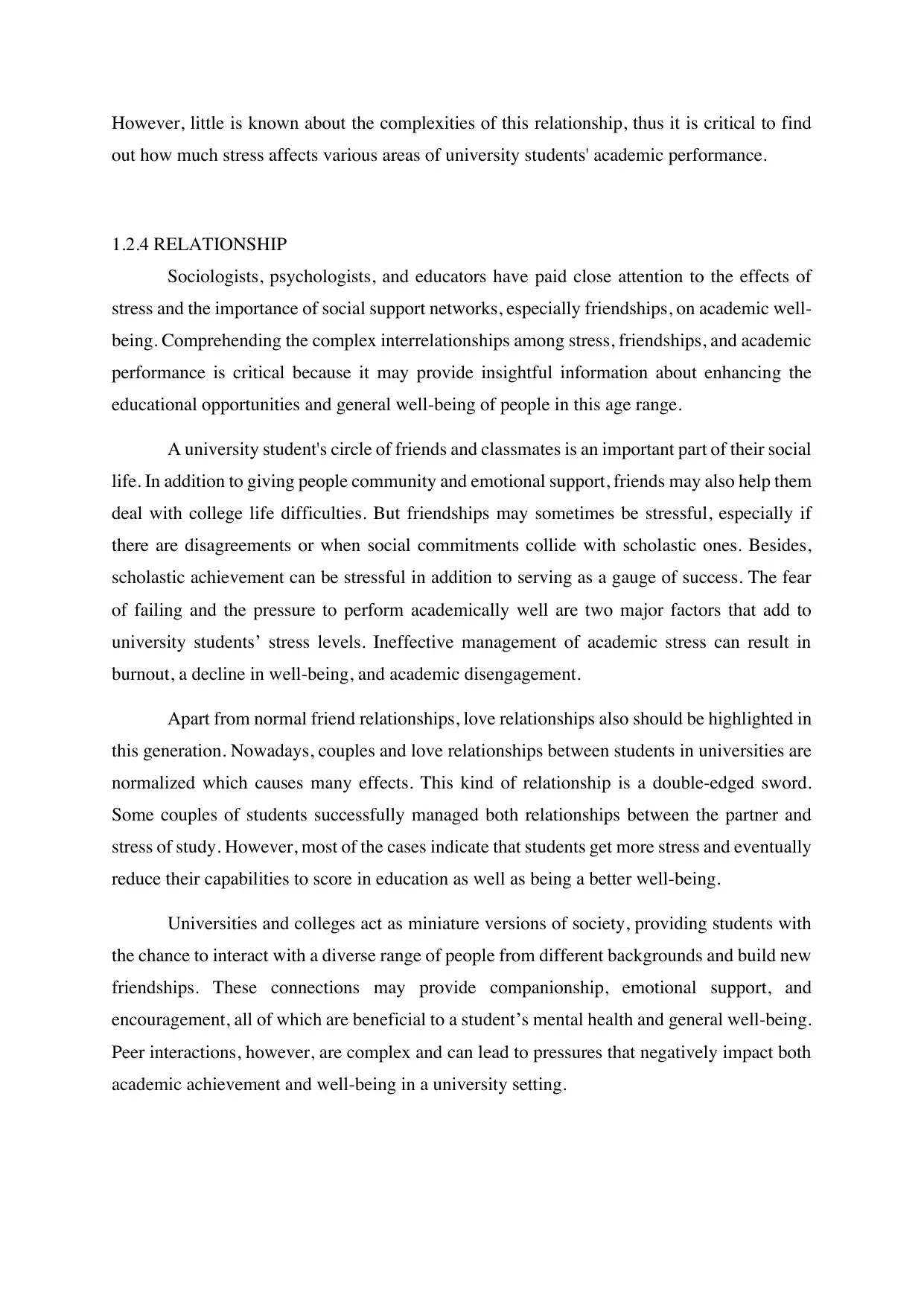
However, little is known about the complexities of this relationship, thus it is critical to find
out how much stress affects various areas of university students' academic performance.
1.2.4 RELATIONSHIP
Sociologists, psychologists, and educators have paid close attention to the effects of
stress and the importance of social support networks, especially friendships, on academic well-
being. Comprehending the complex interrelationships among stress, friendships, and academic
performance is critical because it may provide insightful information about enhancing the
educational opportunities and general well-being of people in this age range.
A university student's circle of friends and classmates is an important part of their social
life. In addition to giving people community and emotional support, friends may also help them
deal with college life difficulties. But friendships may sometimes be stressful, especially if
there are disagreements or when social commitments collide with scholastic ones. Besides,
scholastic achievement can be stressful in addition to serving as a gauge of success. The fear
of failing and the pressure to perform academically well are two major factors that add to
university students’ stress levels. Ineffective management of academic stress can result in
burnout, a decline in well-being, and academic disengagement.
Apart from normal friend relationships, love relationships also should be highlighted in
this generation. Nowadays, couples and love relationships between students in universities are
normalized which causes many effects. This kind of relationship is a double-edged sword.
Some couples of students successfully managed both relationships between the partner and
stress of study. However, most of the cases indicate that students get more stress and eventually
reduce their capabilities to score in education as well as being a better well-being.
Universities and colleges act as miniature versions of society, providing students with
the chance to interact with a diverse range of people from different backgrounds and build new
friendships. These connections may provide companionship, emotional support, and
encouragement, all of which are beneficial to a student’s mental health and general well-being.
Peer interactions, however, are complex and can lead to pressures that negatively impact both
academic achievement and well-being in a university setting.
out how much stress affects various areas of university students' academic performance.
1.2.4 RELATIONSHIP
Sociologists, psychologists, and educators have paid close attention to the effects of
stress and the importance of social support networks, especially friendships, on academic well-
being. Comprehending the complex interrelationships among stress, friendships, and academic
performance is critical because it may provide insightful information about enhancing the
educational opportunities and general well-being of people in this age range.
A university student's circle of friends and classmates is an important part of their social
life. In addition to giving people community and emotional support, friends may also help them
deal with college life difficulties. But friendships may sometimes be stressful, especially if
there are disagreements or when social commitments collide with scholastic ones. Besides,
scholastic achievement can be stressful in addition to serving as a gauge of success. The fear
of failing and the pressure to perform academically well are two major factors that add to
university students’ stress levels. Ineffective management of academic stress can result in
burnout, a decline in well-being, and academic disengagement.
Apart from normal friend relationships, love relationships also should be highlighted in
this generation. Nowadays, couples and love relationships between students in universities are
normalized which causes many effects. This kind of relationship is a double-edged sword.
Some couples of students successfully managed both relationships between the partner and
stress of study. However, most of the cases indicate that students get more stress and eventually
reduce their capabilities to score in education as well as being a better well-being.
Universities and colleges act as miniature versions of society, providing students with
the chance to interact with a diverse range of people from different backgrounds and build new
friendships. These connections may provide companionship, emotional support, and
encouragement, all of which are beneficial to a student’s mental health and general well-being.
Peer interactions, however, are complex and can lead to pressures that negatively impact both
academic achievement and well-being in a university setting.
⊘ This is a preview!⊘
Do you want full access?
Subscribe today to unlock all pages.

Trusted by 1+ million students worldwide
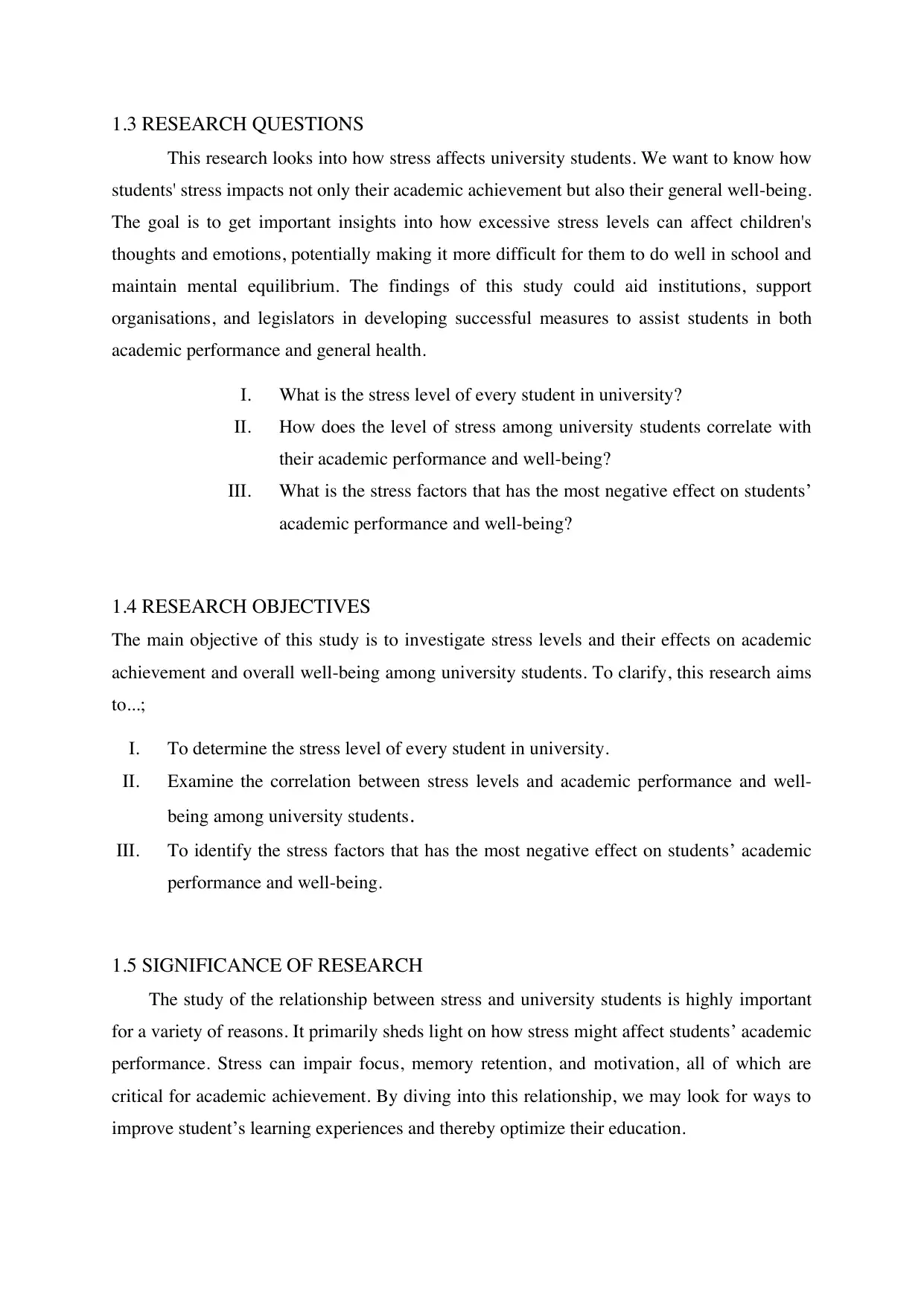
1.3 RESEARCH QUESTIONS
This research looks into how stress affects university students. We want to know how
students' stress impacts not only their academic achievement but also their general well-being.
The goal is to get important insights into how excessive stress levels can affect children's
thoughts and emotions, potentially making it more difficult for them to do well in school and
maintain mental equilibrium. The findings of this study could aid institutions, support
organisations, and legislators in developing successful measures to assist students in both
academic performance and general health.
I. What is the stress level of every student in university?
II. How does the level of stress among university students correlate with
their academic performance and well-being?
III. What is the stress factors that has the most negative effect on students’
academic performance and well-being?
1.4 RESEARCH OBJECTIVES
The main objective of this study is to investigate stress levels and their effects on academic
achievement and overall well-being among university students. To clarify, this research aims
to...;
I. To determine the stress level of every student in university.
II. Examine the correlation between stress levels and academic performance and well-
being among university students.
III. To identify the stress factors that has the most negative effect on students’ academic
performance and well-being.
1.5 SIGNIFICANCE OF RESEARCH
The study of the relationship between stress and university students is highly important
for a variety of reasons. It primarily sheds light on how stress might affect students’ academic
performance. Stress can impair focus, memory retention, and motivation, all of which are
critical for academic achievement. By diving into this relationship, we may look for ways to
improve student’s learning experiences and thereby optimize their education.
This research looks into how stress affects university students. We want to know how
students' stress impacts not only their academic achievement but also their general well-being.
The goal is to get important insights into how excessive stress levels can affect children's
thoughts and emotions, potentially making it more difficult for them to do well in school and
maintain mental equilibrium. The findings of this study could aid institutions, support
organisations, and legislators in developing successful measures to assist students in both
academic performance and general health.
I. What is the stress level of every student in university?
II. How does the level of stress among university students correlate with
their academic performance and well-being?
III. What is the stress factors that has the most negative effect on students’
academic performance and well-being?
1.4 RESEARCH OBJECTIVES
The main objective of this study is to investigate stress levels and their effects on academic
achievement and overall well-being among university students. To clarify, this research aims
to...;
I. To determine the stress level of every student in university.
II. Examine the correlation between stress levels and academic performance and well-
being among university students.
III. To identify the stress factors that has the most negative effect on students’ academic
performance and well-being.
1.5 SIGNIFICANCE OF RESEARCH
The study of the relationship between stress and university students is highly important
for a variety of reasons. It primarily sheds light on how stress might affect students’ academic
performance. Stress can impair focus, memory retention, and motivation, all of which are
critical for academic achievement. By diving into this relationship, we may look for ways to
improve student’s learning experiences and thereby optimize their education.
Paraphrase This Document
Need a fresh take? Get an instant paraphrase of this document with our AI Paraphraser
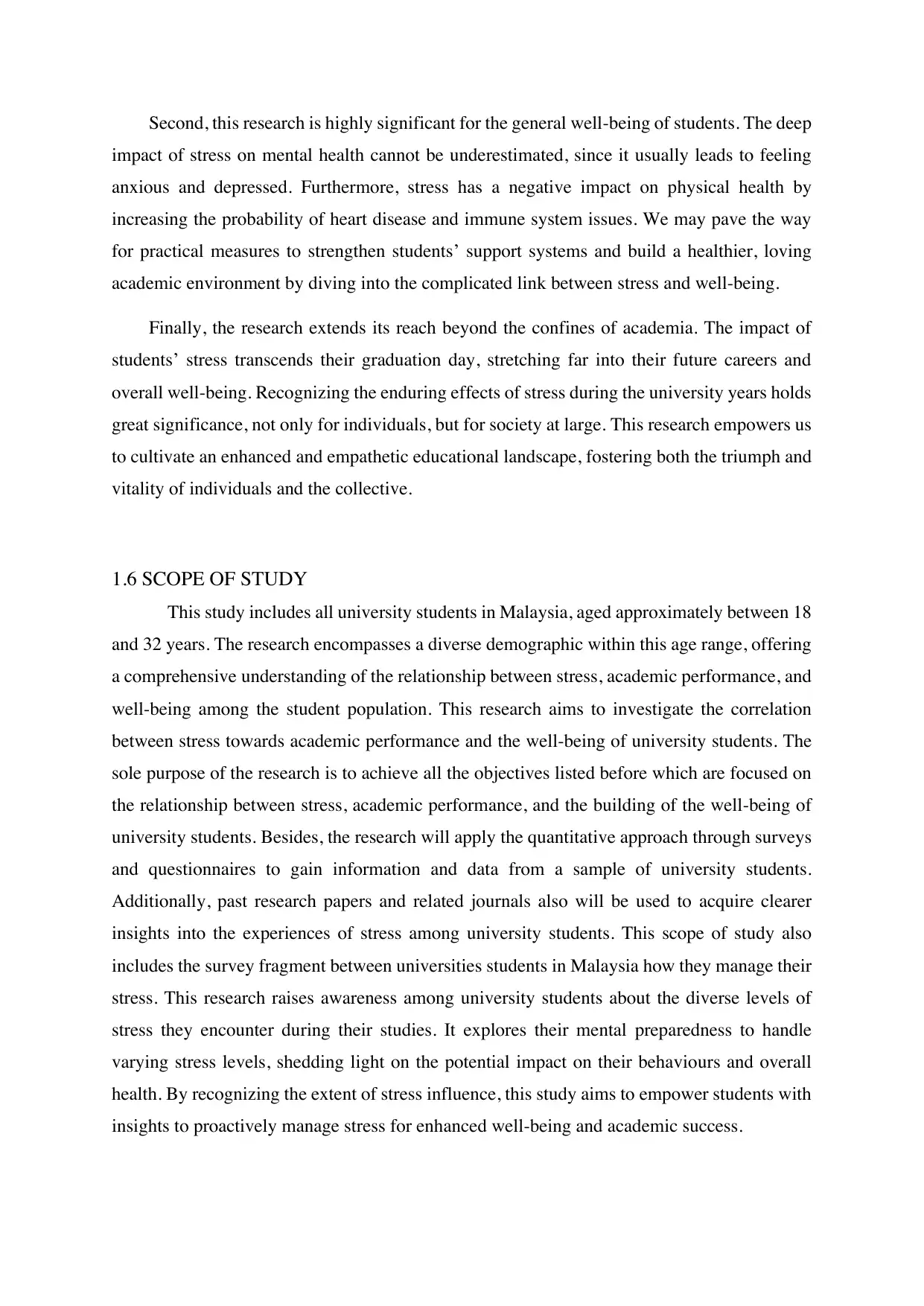
Second, this research is highly significant for the general well-being of students. The deep
impact of stress on mental health cannot be underestimated, since it usually leads to feeling
anxious and depressed. Furthermore, stress has a negative impact on physical health by
increasing the probability of heart disease and immune system issues. We may pave the way
for practical measures to strengthen students’ support systems and build a healthier, loving
academic environment by diving into the complicated link between stress and well-being.
Finally, the research extends its reach beyond the confines of academia. The impact of
students’ stress transcends their graduation day, stretching far into their future careers and
overall well-being. Recognizing the enduring effects of stress during the university years holds
great significance, not only for individuals, but for society at large. This research empowers us
to cultivate an enhanced and empathetic educational landscape, fostering both the triumph and
vitality of individuals and the collective.
1.6 SCOPE OF STUDY
This study includes all university students in Malaysia, aged approximately between 18
and 32 years. The research encompasses a diverse demographic within this age range, offering
a comprehensive understanding of the relationship between stress, academic performance, and
well-being among the student population. This research aims to investigate the correlation
between stress towards academic performance and the well-being of university students. The
sole purpose of the research is to achieve all the objectives listed before which are focused on
the relationship between stress, academic performance, and the building of the well-being of
university students. Besides, the research will apply the quantitative approach through surveys
and questionnaires to gain information and data from a sample of university students.
Additionally, past research papers and related journals also will be used to acquire clearer
insights into the experiences of stress among university students. This scope of study also
includes the survey fragment between universities students in Malaysia how they manage their
stress. This research raises awareness among university students about the diverse levels of
stress they encounter during their studies. It explores their mental preparedness to handle
varying stress levels, shedding light on the potential impact on their behaviours and overall
health. By recognizing the extent of stress influence, this study aims to empower students with
insights to proactively manage stress for enhanced well-being and academic success.
impact of stress on mental health cannot be underestimated, since it usually leads to feeling
anxious and depressed. Furthermore, stress has a negative impact on physical health by
increasing the probability of heart disease and immune system issues. We may pave the way
for practical measures to strengthen students’ support systems and build a healthier, loving
academic environment by diving into the complicated link between stress and well-being.
Finally, the research extends its reach beyond the confines of academia. The impact of
students’ stress transcends their graduation day, stretching far into their future careers and
overall well-being. Recognizing the enduring effects of stress during the university years holds
great significance, not only for individuals, but for society at large. This research empowers us
to cultivate an enhanced and empathetic educational landscape, fostering both the triumph and
vitality of individuals and the collective.
1.6 SCOPE OF STUDY
This study includes all university students in Malaysia, aged approximately between 18
and 32 years. The research encompasses a diverse demographic within this age range, offering
a comprehensive understanding of the relationship between stress, academic performance, and
well-being among the student population. This research aims to investigate the correlation
between stress towards academic performance and the well-being of university students. The
sole purpose of the research is to achieve all the objectives listed before which are focused on
the relationship between stress, academic performance, and the building of the well-being of
university students. Besides, the research will apply the quantitative approach through surveys
and questionnaires to gain information and data from a sample of university students.
Additionally, past research papers and related journals also will be used to acquire clearer
insights into the experiences of stress among university students. This scope of study also
includes the survey fragment between universities students in Malaysia how they manage their
stress. This research raises awareness among university students about the diverse levels of
stress they encounter during their studies. It explores their mental preparedness to handle
varying stress levels, shedding light on the potential impact on their behaviours and overall
health. By recognizing the extent of stress influence, this study aims to empower students with
insights to proactively manage stress for enhanced well-being and academic success.
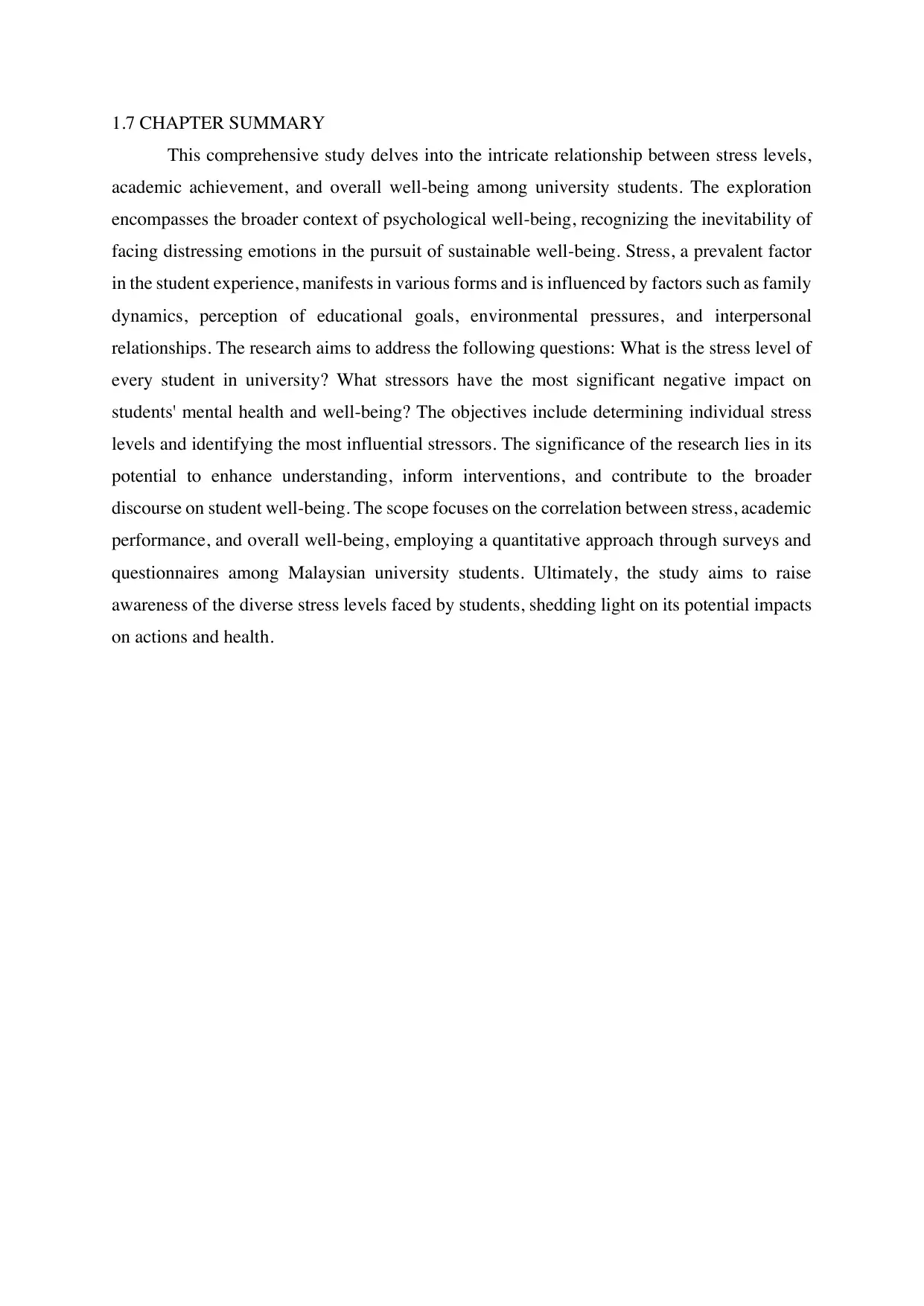
1.7 CHAPTER SUMMARY
This comprehensive study delves into the intricate relationship between stress levels,
academic achievement, and overall well-being among university students. The exploration
encompasses the broader context of psychological well-being, recognizing the inevitability of
facing distressing emotions in the pursuit of sustainable well-being. Stress, a prevalent factor
in the student experience, manifests in various forms and is influenced by factors such as family
dynamics, perception of educational goals, environmental pressures, and interpersonal
relationships. The research aims to address the following questions: What is the stress level of
every student in university? What stressors have the most significant negative impact on
students' mental health and well-being? The objectives include determining individual stress
levels and identifying the most influential stressors. The significance of the research lies in its
potential to enhance understanding, inform interventions, and contribute to the broader
discourse on student well-being. The scope focuses on the correlation between stress, academic
performance, and overall well-being, employing a quantitative approach through surveys and
questionnaires among Malaysian university students. Ultimately, the study aims to raise
awareness of the diverse stress levels faced by students, shedding light on its potential impacts
on actions and health.
This comprehensive study delves into the intricate relationship between stress levels,
academic achievement, and overall well-being among university students. The exploration
encompasses the broader context of psychological well-being, recognizing the inevitability of
facing distressing emotions in the pursuit of sustainable well-being. Stress, a prevalent factor
in the student experience, manifests in various forms and is influenced by factors such as family
dynamics, perception of educational goals, environmental pressures, and interpersonal
relationships. The research aims to address the following questions: What is the stress level of
every student in university? What stressors have the most significant negative impact on
students' mental health and well-being? The objectives include determining individual stress
levels and identifying the most influential stressors. The significance of the research lies in its
potential to enhance understanding, inform interventions, and contribute to the broader
discourse on student well-being. The scope focuses on the correlation between stress, academic
performance, and overall well-being, employing a quantitative approach through surveys and
questionnaires among Malaysian university students. Ultimately, the study aims to raise
awareness of the diverse stress levels faced by students, shedding light on its potential impacts
on actions and health.
⊘ This is a preview!⊘
Do you want full access?
Subscribe today to unlock all pages.

Trusted by 1+ million students worldwide
1 out of 61
Related Documents
Your All-in-One AI-Powered Toolkit for Academic Success.
+13062052269
info@desklib.com
Available 24*7 on WhatsApp / Email
![[object Object]](/_next/static/media/star-bottom.7253800d.svg)
Unlock your academic potential
Copyright © 2020–2025 A2Z Services. All Rights Reserved. Developed and managed by ZUCOL.





